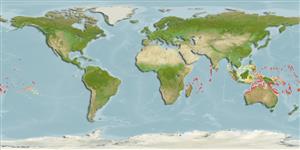>
Anguilliformes (Eels and morays) >
Muraenidae (Moray eels) > Muraeninae
Etymology: Gymnothorax: Greek, gymnos = naked + Greek, thorax, -akos = breast (Ref. 45335).
More on author: Schultz.
Environment: milieu / climate zone / depth range / distribution range
Ökologie
seewasser riff-verbunden; tiefenbereich ? - 25 m (Ref. 1602). Tropical; 12°N - 24°S
Indo-Pacific: East Africa to Tuamoto Islands and Fiji (Ref 001602); Philippines, south to Australia (Ref 90102).
Length at first maturity / Size / Gewicht / Alter
Maturity: Lm ?, range 13 - ? cm
Max length : 20.0 cm TL Männchen/unbestimmt; (Ref. 2334)
Kurzbeschreibung
Morphologie | Morphometrie
Rückenflossenstacheln (insgesamt): 0; Rückenflossenweichstrahlen (insgesamt): 0; Afterflossenstacheln 0; Afterflossenweichstrahlen: 0; Wirbelzahl: 112 - 122. Pale brown, evenly marked with round, dark brown spots (Ref. 3257). Dorsal fin begins far from the head, closer to the anus. Teeth short and conical.
Occurs among corals and rubble of seaward reefs. Very secretive (Ref. 9710, 75154). Benthic at 1-22 m (Ref. 58302, 75154).
Life cycle and mating behavior
Geschlechtsreife | Fortpflanzung | Ablaichen | Eier | Fecundity | Larven
Randall, J.E., G.R. Allen and R.C. Steene, 1990. Fishes of the Great Barrier Reef and Coral Sea. University of Hawaii Press, Honolulu, Hawaii. 506 p. (Ref. 2334)
IUCN Rote Liste Status (Ref. 130435)
Bedrohung für Menschen
Harmless
Nutzung durch Menschen
Mehr Information
ReferenzenAquakulturAquakultur ProfilZuchtlinienGenetikElectrophoresesVererbbarkeitKrankheitenVerarbeitungNutrientsMass conversion
PartnerBilderStamps, Coins Misc.LauteCiguateraGeschwindigkeitSchwimmstilKiemenoberflächeOtolithsGehirngrößeSehfähigkeit
Tools
Zusatzinformationen
Download XML
Internet Quellen
Estimates based on models
Preferred temperature (Ref.
123201): 25.5 - 29.3, mean 28.2 °C (based on 1482 cells).
Phylogenetic diversity index (Ref.
82804): PD
50 = 0.5000 [Uniqueness, from 0.5 = low to 2.0 = high].
Bayesian length-weight: a=0.00047 (0.00025 - 0.00089), b=3.28 (3.13 - 3.43), in cm total length, based on LWR estimates for this Genus-body shape (Ref.
93245).
Trophic level (Ref.
69278): 3.6 ±0.6 se; based on size and trophs of closest relatives
Widerstandsfähigkeit (Ref.
120179): hoch, Verdopplung der Population dauert weniger als 15 Monate. (Preliminary K or Fecundity.).
Fishing Vulnerability (Ref.
59153): Low vulnerability (10 of 100).
Nutrients (Ref.
124155): Calcium = 79.2 [44.2, 164.3] mg/100g; Iron = 0.643 [0.374, 1.237] mg/100g; Protein = 18.7 [16.4, 21.3] %; Omega3 = 0.132 [0.059, 0.389] g/100g; Selenium = 26.7 [13.8, 58.8] μg/100g; VitaminA = 118 [35, 374] μg/100g; Zinc = 1.31 [0.90, 1.87] mg/100g (wet weight);
